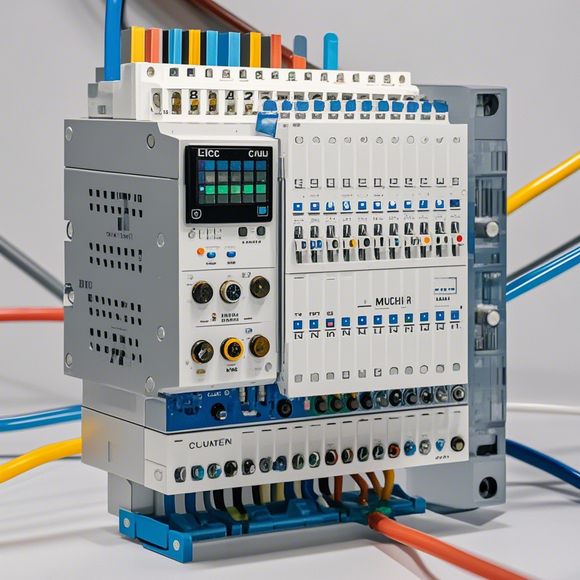Emergency Handling Guide for PLC Controller Failures
In the event that your PLC (Programmable Logic Controller) controller fails, it is important to have a well-thought-out guide on how to handle the emergency. Here's a summary of steps you can take:1. Identify the cause of the failure: Firstly, determine what caused the PLC controller to malfunction. This could be due to a software error, hardware issue, or power outage.2. Call for professional help: If the problem is beyond your expertise, contact a PLC expert or technician who specializes in this type of equipment.3. Backup system: If the primary system is not operational, switch to a backup system. This may involve switching off some functions of the main system or rerouting traffic through alternative systems.4. Monitor and report: Regular monitoring of the PLC system will help identify any new issues or changes in operation. Report these findings to the relevant personnel or department responsible for the system.5. Prevention measures: Finally, implement preventative measures that can reduce the likelihood of PLC controller failures in the future. This may involve regular maintenance and upgrades, as well as training staff on how to properly operate and maintain the equipment.
Introduction to PLC Controllers
PLC controllers, or programmable logic controllers, are essential tools in modern manufacturing and automation. These devices are designed to control various industrial processes by processing information from sensors and other input devices. They can also perform calculations based on predefined algorithms, which allows them to respond to changing conditions without human intervention. The ability of PLCs to process data quickly and precisely makes them ideal for industries that require precise control of machinery and equipment. However, like any technology, PLCs can encounter problems that need to be addressed promptly. In this guide, we will explore the steps necessary to handle emergency situations involving PLC controller failures.

Common Causes of PLC Controller Failure
One of the most common causes of PLC controller failure is hardware issues such as faulty wiring or damaged components. Other common reasons include software errors, improper programming, and environmental factors such as temperature and humidity changes. Additionally, power outages or surges can cause temporary system downtime, which may lead to unexpected behavior or errors. It's important to note that each case requires a thorough investigation to pinpoint the exact cause of the failure. This includes reviewing the operating logs, conducting tests, and examining the physical environment of the PLC controller.
Emergency Response Steps
When facing an emergency situation with a PLC controller failure, it's crucial to take immediate action to prevent further damage or loss of production. Here are the steps you should follow:
1、Identify the PLC Controller's Location
First, determine the location of the PLC controller in your facility. Knowing its position can help you access it more easily during an emergency response. If possible, mark it with a marker so that it is easy to locate during emergencies.
2、Isolate the PLC Controller

Once you have identified the PLC controller, it's critical to isolate it from the rest of your system. This can involve disconnecting power, grounding, and isolating the network connection. Ensure that no other devices are currently connected to the same network, as they may also experience interference or errors.
3、Diagnose the PLC Controller
Using diagnostic tools such as a multimeter, oscilloscope, or network analyzer, you can test the PLC controller for any electrical or software faults. Check for signs of overheating, short circuits, or other abnormal behavior. If possible, run a series of tests to identify the root cause of the problem.
4、Perform Software Updates or Reprogramming
If the problem is related to software errors, you may need to reprogram or update the PLC controller's firmware. This could involve downloading new firmware updates or performing manual programming. Be sure to follow the manufacturer's instructions carefully when updating software.
5、Address Environmental Issues
Environmental factors such as temperature and humidity can affect the performance of PLC controllers. Ensure that your facility is well-ventilated and that the temperature inside the room is within the recommended range for your specific PLC controller. You may also need to adjust the humidity levels if they are too high or too low.

6、Contact Manufacturer Support
If you are unsure how to proceed or need additional assistance, contact the manufacturer's customer support team. They can provide guidance on how to diagnose and fix the PLC controller's issue and offer technical support if needed.
7、Conduct a Post-Mortem Analysis
After the emergency has been resolved, it's important to conduct a post-mortem analysis to determine what caused the failure and how you can prevent similar incidents in the future. This analysis can include reviewing the operating logs, examining the physical environment of the PLC controller, and assessing any potential risks for future occurrences. By learning from past mistakes, you can improve the reliability and efficiency of your PLC controllers.
Content expansion reading:
Articles related to the knowledge points of this article:
The cost of a PLC Controller: A Comprehensive Analysis
PLC (Programmable Logic Controller) Control System Basics
Plumbers Rule! The Role of PLC Controllers in the World of Waterworks
The Role of Programmable Logic Controllers (PLCs) in Foreign Trade Operations
Connecting a PLC Controller to Your Computer
PLC Controllers: A Comprehensive Guide to Understanding Their Prices